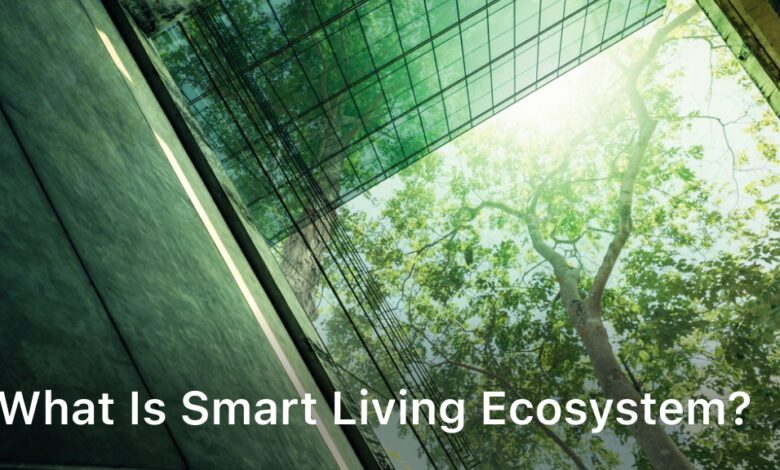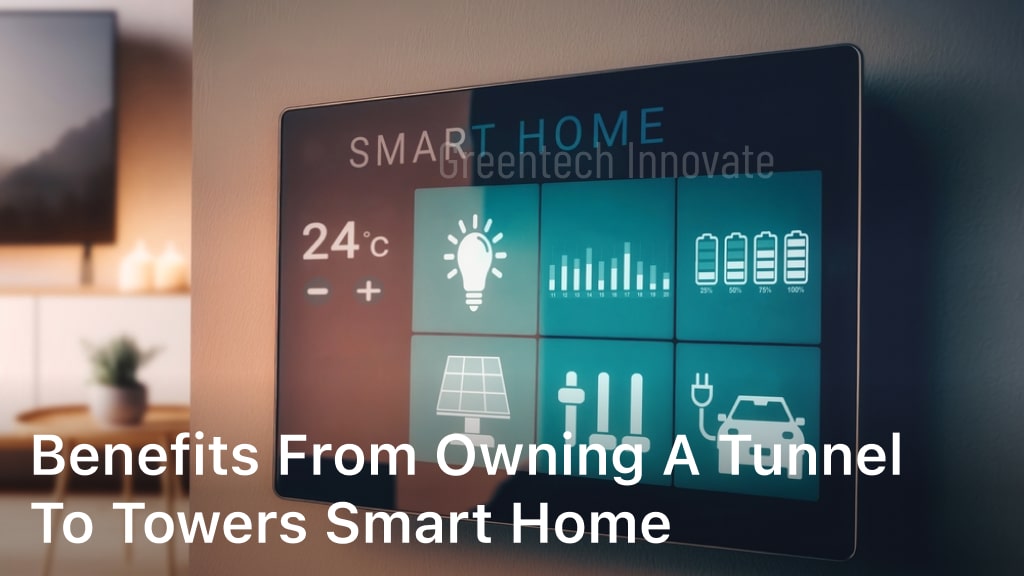
Welcome to the future of home innovation! In this rapidly evolving technological era, smart living ecosystems are revolutionizing our daily lives and transforming our living spaces. These innovative systems combine the power of technology, comfort, and efficiency to create a seamless and intuitive living environment.
Imagine a home where everything is interconnected, where devices communicate with each other, anticipating our needs and simplifying our tasks. This is the essence of a smart living ecosystem, where cutting-edge technologies are seamlessly integrated to enhance our comfort and streamline our daily routines.
Smart living ecosystems utilize a wide range of technologies, such as smart thermostats, lighting systems, and home devices, all orchestrated to create an environment tailored to our preferences. These systems go beyond mere automation, allowing us to control and monitor our living spaces remotely, ensuring maximum comfort and efficiency.
With the constant advancements in technology, the possibilities for smart living ecosystems are endless. From energy management systems to time-saving devices, these ecosystems are designed to make our lives easier, more convenient, and more sustainable.
Join us as we explore the intricacies of smart living ecosystems, understanding how they enhance comfort, efficiency, and sustainability in our daily lives. Discover how technology is reshaping our future, transforming the way we interact with our homes, and paving the way for a more connected and intelligent living experience.
Welcome to the future of home innovation. Welcome to the world of smart living ecosystems.
Understanding Smart Living Ecosystems
In this section, we will delve deeper into the concept of smart living ecosystems and provide a comprehensive understanding of this innovative concept. Smart living ecosystems are more than just a collection of smart devices in our homes; they are an interconnected network designed to enhance our daily lives through technology and automation.
So, what exactly are smart living ecosystems? Simply put, they are intelligent systems that integrate various components and technologies to create a seamless and efficient living environment. These ecosystems typically include smart devices, sensors, connectivity infrastructure, and artificial intelligence algorithms that work together to optimize our daily routines and improve our overall quality of life.
At the core of a smart living ecosystem lies the ability to connect and control devices through a centralized hub or a smartphone application. This central hub acts as the nerve center, enabling communication and coordination between different devices. Through this hub, homeowners can monitor and control various aspects of their living space, such as lighting, temperature, security, and entertainment, from anywhere at any time.
Smart living ecosystems incorporate a wide range of technologies to create a truly intelligent and intuitive living space. These technologies include voice control assistants, smart speakers, connected appliances, smart thermostats, home security systems, and much more. By harnessing the power of these technologies, smart living ecosystems strive to create a more convenient, comfortable, and energy-efficient living environment.
With a better understanding of smart living ecosystems, we can now explore the specific components and technologies that make them possible. In the next sections, we will discuss how these ecosystems enhance comfort with technology, improve efficiency in our daily lives, and envision the future of home innovation.
Enhancing Comfort with Technology
In today’s fast-paced world, we all crave comfort and convenience in our daily lives. Thanks to the advancements in technology, smart living ecosystems have emerged as a solution to enhance comfort in our homes. These ecosystems utilize cutting-edge technologies to create a seamless and comfortable living environment.
One of the key components of a smart living ecosystem is the smart thermostat. This innovative device allows you to control the temperature of your home remotely, ensuring that you always come back to a comfortable space. With the ability to learn your preferences and adapt to your schedule, smart thermostats provide personalized comfort while optimizing energy efficiency.
Lighting systems also play a significant role in enhancing comfort within a smart living ecosystem. Smart bulbs and lighting controls allow you to adjust the brightness and color of your lights according to your mood and activities. You can create the perfect ambiance for relaxation, work, or entertainment with just a few taps on your smartphone.
Creating the Perfect Ambiance
In addition to thermostats and lighting, there are various other smart devices that contribute to enhancing comfort. Smart speakers with voice assistants, such as Amazon Echo or Google Home, allow you to control your music, set reminders, and even adjust the lighting without lifting a finger. These voice-controlled devices add convenience and make your daily routines more enjoyable.
Smart blinds and curtains are another technology-driven solution that enhances comfort in your living space. With the ability to open and close at specific times or in response to your commands, these automated window treatments provide privacy, block out unwanted sunlight, and create a cozy atmosphere at any time of the day.
Continuous Innovation for Comfort
As technology continues to evolve, so do the possibilities for enhancing comfort in our daily lives. The integration of artificial intelligence (AI) and machine learning algorithms allows smart devices to anticipate our needs and preferences, further enhancing the comfort and convenience they provide.
Imagine coming home from a long day at work, and as you step through the front door, your smart living ecosystem adjusts the lighting, temperature, and plays your favorite relaxing music. These personalized experiences make us feel truly at home, enhancing our comfort and overall well-being.
In conclusion, smart living ecosystems utilize technology to enhance comfort in our daily lives. From smart thermostats and lighting systems to voice-controlled devices and automated window treatments, these innovative solutions create a comfortable living environment that adapts to our needs. As technology continues to advance, we can expect even more exciting developments that further enhance our comfort and make our homes a haven of relaxation and convenience.
Improving Efficiency in Daily Life
One of the key benefits of smart living ecosystems is their ability to improve efficiency in various aspects of our daily lives. By leveraging advanced technologies and innovative design, these ecosystems offer a range of solutions that can streamline our tasks and reduce waste, ultimately making our lives more productive and convenient.
Time-saving devices are a cornerstone of smart living ecosystems. From automated home assistants that can manage our schedules and reminders to smart appliances that can perform tasks autonomously, these devices free up valuable time that can be better allocated to other activities.
Energy management systems are another crucial aspect of improving efficiency. With smart features such as automated lighting controls, thermostats that adjust to our preferences, and energy monitoring tools, we can optimize our energy usage and reduce unnecessary waste. By efficiently managing energy resources, we not only contribute to a greener future but also save on utility costs.
Additionally, smart appliances play a significant role in improving efficiency in daily life. From smart refrigerators that help manage grocery inventory and suggest recipes based on available ingredients to smart washing machines that adjust water levels and cycle durations based on load size, these appliances take the guesswork out of household chores and ensure optimal efficiency.
Furthermore, the connectivity and integration within smart living ecosystems enable seamless coordination between devices. For example, a smart thermostat can adjust the temperature based on data from your smartwatch, ensuring optimal comfort while saving energy. These interconnected systems enhance efficiency by automating processes and adapting to our needs, simplifying our daily routines.
Improving Efficiency in Daily Life: Key Points
- Time-saving devices automate tasks and free up valuable time.
- Energy management systems optimize energy usage and reduce waste.
- Smart appliances streamline household chores and ensure optimal efficiency.
- Seamless connectivity and integration enhance automation and adaptability.
The Future of Home Innovation
In this section, we will take a glimpse into the future of home innovation driven by smart living ecosystems. With continuous advancements in technology, our living spaces are set to undergo transformative changes that will enhance our daily lives in unprecedented ways.
Emerging Technologies: Artificial Intelligence and IoT
Artificial intelligence (AI) and the Internet of Things (IoT) are emerging technologies that are shaping the future of home innovation. AI-powered devices and systems have the ability to learn and adapt to our preferences, creating personalized experiences within our living spaces.
The IoT connects everyday objects and appliances to the internet, enabling seamless communication and automation. Through interconnected devices, we can control and monitor various aspects of our homes, improving convenience and efficiency.
Potential Impact on Living Spaces
The integration of AI and IoT in smart living ecosystems holds immense potential for transforming our living spaces. Imagine a home that anticipates our needs, adjusts the lighting and temperature to enhance our comfort, and manages our energy consumption to be more sustainable.
Smart homes of the future may feature intelligent voice assistants that can effortlessly perform tasks and provide valuable information. Connected appliances and systems can work harmoniously to simplify our daily routines and make our lives more efficient.
Additionally, the future of home innovation may bring advancements in security and safety. Smart surveillance systems and facial recognition technology can provide enhanced protection for our homes and loved ones.
Embracing the Future
As we enter the era of smart living ecosystems, it is crucial for homeowners to embrace the future of home innovation. By incorporating AI and IoT technologies into our homes, we can enjoy a more connected, convenient, and sustainable lifestyle.
The possibilities are endless, and the future of home innovation promises to revolutionize how we interact with our living spaces. With each technological advancement, we move closer to realizing the full potential of smart living ecosystems, creating a future where our homes cater to our every need.
- Improved comfort through personalized experiences
- Enhanced efficiency and sustainability
- Convenience through automation and connectivity
- Advanced security and safety features
Transforming Our Living Spaces
Smart living ecosystems have revolutionized the way we interact with our living spaces, offering endless possibilities for transformation. Through the integration of smart devices, automation, and personalized experiences, these ecosystems create a seamless and intuitive living environment.
Imagine waking up to a gentle, simulated sunrise as the smart lighting gradually illuminates your bedroom. The thermostat adjusts to the perfect temperature, ensuring optimal comfort. As you make your way to the kitchen, your smart coffee maker has already brewed a fresh cup of coffee, thanks to the automation feature.
The Benefits of Smart Living Ecosystems
- Enhanced convenience: Smart living ecosystems allow you to control various aspects of your home with ease, right from your smartphone or voice-activated devices.
- Energy efficiency: By integrating smart thermostats, lighting systems, and appliances, you can significantly reduce energy consumption and lower utility bills.
- Personalization: Smart living ecosystems adapt to your preferences and routines, providing a customized experience that suits your lifestyle.
- Increased security: With smart security systems, you can monitor your home remotely, receive alerts, and even control access to your property.
Creating an Intuitive Living Environment
Smart living ecosystems transform our living spaces into intuitive environments that anticipate our needs. As you enter a room, motion sensors detect your presence and automatically adjust the lighting and temperature to your liking. Voice-controlled assistants respond to your commands, allowing you to control various devices in your home effortlessly.
Furthermore, smart devices can seamlessly communicate with each other, creating a harmonious ecosystem of interconnected technology. For example, your smart refrigerator can notify your smart grocery list to reorder items that are running low. Your smart entertainment system can sync with your smart lighting, immersing you in a cinematic experience.
By transforming our living spaces into smart living ecosystems, we can enjoy unparalleled comfort, convenience, and efficiency in our daily lives. The possibilities are limitless, and the future of home innovation looks incredibly promising.
Conclusion
In conclusion, smart living ecosystems have the potential to significantly enhance comfort and efficiency in our daily lives. Through continuous advancements in technology, these ecosystems offer endless possibilities for transforming our living spaces into more convenient and sustainable environments.
By embracing smart living ecosystems, individuals can experience the benefits of automation, personalized experiences, and seamless integration of smart devices. This revolutionizes the way we interact with our homes, simplifying tasks and creating a more intuitive living environment.
The future of home innovation looks promising, with emerging technologies such as artificial intelligence and the Internet of Things (IoT) driving the evolution of smart living ecosystems. As we embrace these technologies, we pave the way for a lifestyle that is not only more convenient, but also more environmentally friendly, through optimized energy management and reduced waste.
FAQ
What is a smart living ecosystem?
A smart living ecosystem refers to a network of interconnected devices and technologies that work together to enhance comfort, efficiency, and convenience in our daily lives. By integrating various smart devices, such as thermostats, lighting systems, and appliances, a smart living ecosystem creates an intelligent and automated living environment.
How does a smart living ecosystem work?
A smart living ecosystem consists of different components, such as sensors, actuators, and a central control hub, that communicate with each other through a wireless network. These devices collect and analyze data, allowing users to monitor and control various aspects of their homes remotely. The central hub acts as a command center, coordinating the functions of different devices to create a seamless and personalized living experience.
How can a smart living ecosystem enhance comfort in daily life?
A smart living ecosystem enhances comfort by providing automated control over temperature, lighting, and other home devices. With a smart thermostat, for example, you can customize your home’s temperature according to your preferences and schedule. Similarly, smart lighting systems offer features like color changing and dimming options, creating a more relaxed and cozy ambiance.
How does a smart living ecosystem improve efficiency in daily life?
A smart living ecosystem improves efficiency by automating routine tasks and optimizing resource consumption. For instance, smart appliances can be programmed to run during off-peak hours when energy costs are lower. Additionally, energy management systems monitor and regulate energy usage, minimizing wastage and leading to cost savings.
What is the future of home innovation with smart living ecosystems?
The future of home innovation with smart living ecosystems is promising. Advancements in technologies like artificial intelligence and Internet of Things (IoT) are enabling more intelligent and intuitive living spaces. This includes features like voice-controlled assistants, personalized experiences, and predictive automation, making our homes even smarter and adaptable to our needs.
How do smart living ecosystems transform our living spaces?
Smart living ecosystems transform our living spaces by seamlessly integrating smart devices and automation. By connecting various aspects of our homes, such as lighting, security, and entertainment systems, a smart living ecosystem creates a cohesive and user-friendly environment. This means that you can control and manage these features with ease, resulting in a more convenient and enjoyable living experience.





